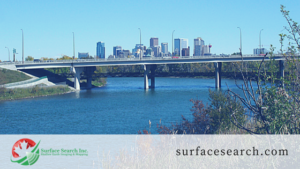Seismic Reflection (both on-shore and marine) is the most common geophysical methodology used for oil and gas exploration and exhibits the highest degree of technical sophistication in terms of both data acquisition and signal processing capabilities. Seismic reflection surveys provide either 2 or 3 dimensional imagery of stratigraphic boundaries and geologic structure (e.g. faults, stratigraphic layering, folding) at depths ranging from 100’s of metres to several kilometres in depth.
Seismic reflections occur at boundaries in rock densities which give rise to “reflected” acoustic energy. For shallow ground exploration, seismic reflection can be an effective method in profiling upper bedrock surface depths as well as deeper litho-stratigraphic features. Compared with other shallow geophysical methods however (e.g. GPR, ERT, SR), Seismic Reflection surveys tend to be more expensive because of comparatively higher equipment and labor requirements.
When required, Surface Search Inc. subcontracts conventional seismic data acquisition and signal processing companies to collect Seismic Reflection data on behalf of our clients. We offer full signal analysis and interpretation services for seismic reflection surveys.
[x_callout type=”left” title=”Looking for a Solution?” message=”A comprehensive understanding of what lies beneath the surface within the confines of your project area matters. Encountering unforeseen subsurface features can be detrimental to your overall project budget and completion schedule.” button_text=”Contact Us Now” button_icon=”phone-square” href=”https://surfacesearch.com/contact-2/”]



